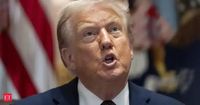On September 1, 2025, President Donald Trump’s administration unveiled a bold—and controversial—plan to slap tariffs as high as 200% on imported pharmaceuticals. The stated goal? To reduce America’s dependence on foreign drugmakers and bolster domestic production, especially after the supply chain chaos and stockpiling that plagued the country during the COVID-19 pandemic. Yet, as the details emerge, experts warn that these tariffs could have far-reaching and painful consequences for millions of Americans who depend on affordable medication.
For decades, pharmaceuticals have mostly entered the United States duty free, even as Trump’s trade wars targeted everything from autos to steel. Now, that’s changing. According to The Associated Press, Trump’s team invoked national security concerns under Section 232 of the Trade Expansion Act of 1962, arguing that the country’s reliance on overseas drug production leaves it vulnerable in times of crisis. The administration’s message is clear: domestic production must rise, and quickly.
But the industry’s reaction has been swift and full of anxiety. "Shock and awe is how this industry is going from zero (tariffs) to the potential of 200%," said Maytee Pereira of PwC in an interview with AP. She didn’t mince words about the challenge ahead: "The only way to truly protect yourself from the tariffs would be to build the supply chain end to end in the United States." That, of course, is easier said than done. Drugmakers have spent decades moving production to places like China, India, Ireland, and Switzerland, drawn by lower costs and friendlier tax regimes. Building a full supply chain at home would take years and cost billions.
In the meantime, the White House has suggested a delay of one to one and a half years before the tariffs take effect, to give companies time to adjust. Many pharmaceutical giants have already started to hedge their bets, boosting imports and building up inventories. Leerink Partners analyst David Risinger noted that most drugmakers now have between six and 18 months of inventory stateside, which could soften the initial blow. Jefferies analyst David Windley echoed this, telling The Economic Times that tariffs starting in late 2026 may not be felt by consumers until 2027 or 2028, as stockpiles gradually run down.
Still, the writing is on the wall. The U.S. ran a nearly $150 billion trade deficit in medicinal and pharmaceutical products last year, according to The Economic Times. And the dependence is deep: 97% of antibiotics, 92% of antivirals, and 83% of top generic drugs contain at least one active ingredient manufactured abroad. Jacob Jensen, a trade policy analyst at the American Action Forum, underscored just how complicated any quick fix would be.
So how will consumers feel the impact? Diederik Stadig of ING spelled it out in a recent commentary: "A tariff would hurt consumers most of all, as they would feel the inflationary effect ... directly when paying for prescriptions at the pharmacy and indirectly through higher insurance premiums." He added that low-income households and the elderly would be most exposed. Stadig estimated that even a 25% tariff could raise U.S. drug prices by 10 to 14% as stockpiles run down—a staggering number for anyone on a fixed income.
Generics, which make up about 92% of retail and mail-order pharmacy prescriptions in the U.S., are particularly at risk. These drugs are typically sold at razor-thin margins, and many manufacturers may not be able to absorb the extra cost. Some could leave the U.S. market altogether rather than pay the tariffs, analysts warn, potentially triggering shortages and driving prices even higher. As Kotak Institutional Equities told The Economic Times, companies might cut their U.S. portfolios or exit certain low-margin lines if tariffs remain high.
Major pharmaceutical companies are doing what they can to adapt. Roche announced in April it will invest $50 billion to expand U.S. operations, while Johnson & Johnson plans to spend $55 billion over the next four years, aiming to supply the American market from domestic sites. Eli Lilly has also ramped up domestic manufacturing. But as The Economic Times points out, investment pledges don’t instantly replace the foreign-made active ingredients still used in many products. The transition will be slow and costly.
Interestingly, the administration has carved out a temporary exemption for India, which supplies a large share of global generics and provides crucial ingredients. Sudarshan Jain, Secretary General of the Indian Pharmaceutical Alliance, told ANI that India’s pharmaceutical industry has been "excluded" from immediate tariff enforcement because its generics are "crucial" for affordable care in the United States. Sandeep Pandey, co-founder at Basav Capital, noted that India’s share of U.S. pharmaceutical imports is about 6%, and policymakers recognize the system’s dependence on Indian supplies.
But even these exemptions can’t hide the underlying fragility of the system. Marta Wosinska of the Brookings Institution reminded The Economic Times of a recent incident: "A production pause at a factory in India a few years ago led to a chemotherapy shortage. Those are not very resilient markets. If there’s a shock, it’s hard for them to recover." She added, "If we want to reverse this, we would really have to redesign our system ... How much are we willing to spend?"
Legal challenges have already begun to pile up. The U.S. Court of Appeals for the Federal Circuit struck down parts of the tariff plan, arguing that such sweeping economic measures require explicit congressional authorization. That decision was temporarily stayed, and the case is now headed to the Supreme Court. The outcome could have far-reaching implications for presidential power and trade policy, and everyone from business leaders to patients is watching closely.
Meanwhile, Trump’s approach to health policy is shifting in other ways. In a recent Truth Social post, he backed Health and Human Services Secretary Robert F. Kennedy Jr. in debates over vaccine safety and efficacy—an about-face from his previous endorsements. Trump has also demanded that Pfizer and other pharmaceutical companies release full data on their COVID-19 vaccines, openly questioning the success of Operation Warp Speed, which he once hailed as a triumph.
For now, the administration’s message is one of tough choices and trade-offs. Policymakers must weigh the desire for greater production resilience in the United States against the need to keep medicines affordable and widely available today. As The Economic Times put it, "The tariff threat forces a trade-off between two goals. One is greater production resilience in the United States. The other is keeping medicines affordable and widely available today. Policymakers face a hard choice and so do patients."
With stockpiles delaying immediate shortages but price hikes looming, Americans who rely on regular prescriptions are being urged to check with their pharmacists about alternatives and to keep a close eye on court rulings and official tariff lists. The stakes, it seems, could hardly be higher.


